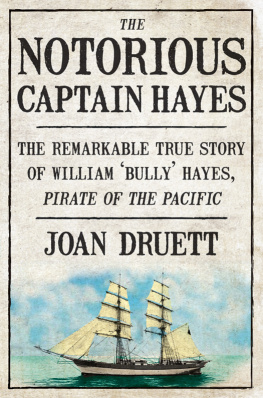CONTENTS
Guide
NON FICTION
Lady Castaways
Eleanors Odyssey, Journal of the Captains Wife on the East Indiaman
Friendship, 1799-1801
The Elephant Voyage
Tupaia, The Remarkable Story of Captain Cooks Polynesian Navigator
Island of the Lost
In the Wake of Madness
Rough Medicine
She Captains
Hen Frigates
The Sailing Circle (with Mary Anne Wallace)
Captains Daughter, Coastermans Wife
She Was a Sister Sailor, Mary Brewsters Whaling Journals, 1845-1851
Petticoat Whalers
Fulbright in New Zealand Exotic Intruders
FICTION
Abigail
A Promise of Gold
Murder at the Brian Boru
A Watery Grave
Shark Island
Run Afoul
Deadly Shoals
The Beckoning Ice
HarperCollinsPublishers
First published in 2016
by HarperCollinsPublishers (New Zealand) Limited
Unit D1, 63 Apollo Drive, Rosedale, Auckland 0632, New Zealand
harpercollins.co.nz
Copyright Joan Druett 2016
Joan Druett asserts the moral right to be identified as the author of this work. This work is copyright. All rights reserved. No part of this publication may be reproduced, copied, scanned, stored in a retrieval system, recorded, or transmitted, in any form or by any means, without the prior written permission of the publisher.
HarperCollinsPublishers
Level 13, 201 Elizabeth Street, Sydney, NSW 2000, Australia
Unit D1, 63 Apollo Drive, Rosedale, Auckland 0632, New Zealand
A 53, Sector 57, Noida, UP, India
1 London Bridge Street, London SE1 9GF, United Kingdom
2 Bloor Street East, 20th floor, Toronto, Ontario M4W 1A8, Canada
195 Broadway, New York, NY 10007, USA
ISBN 978 1 7755 4097 7 (pbk)
ISBN 978 1 7754 9135 4 (ebook)
A catalogue record for this book is available from the National Library of New Zealand
Cover design by Darren Holt, HarperCollins Design Studio
Cover image by shutterstock.com

Map from Rolf Boldrewood, A Modern Buccaneer, London, 1894
Talk in the South Seas is all upon one pattern; it isa wide ocean, indeed, but a narrow world: you shall never talk long and not hear the name of Bully Hayes.
Robert Louis Stevenson, The Wrecker
R omance has coloured stories of the Pacific ever since the day in 1769 when the first European seamen came home from Tahiti, firing the public imagination with tales of beautiful bare-breasted girls beckoning seductively from groves of swaying palms. From that pivotal moment an enduring passion for stories about tropical islands was born, as amazing yarns drifted back from those who were exploring this great new ocean. The trouble was, the Pacific did not have a legendary pirate America had Captain Kidd, the Caribbean had Captain Morgan, the Mediterranean had Barbarossa, and the Atlantic had Blackbeard, but the Pacific had just whalers and explorers. Though hardy and adventurous folk, they were not the stuff of sensational newspaper stories.
But then, in the mid-nineteenth century, Captain William Henry Hayes arrived.
Wherever he went, a tsunami of headlines seethed in his wake, starting with the storm he raised in the Eastern ports of Hong Kong and Singapore. T HE H ISTORY OF A C ONSUMMATE S COUNDREL blared a Honolulu paper in September 1859, just months after he had arrived in Hawaii, while Australian papers ran their own exposs the following year, under the heading T HE N OTORIOUS C APTAIN H AYES , describing with relish one of the most systematic and unmitigated scoundrels who had ever dropped anchor in the colony.
This was addictive reading. Subscribers were fascinated, and news stands were besieged by eager buyers who wanted to know the latest grisly details. The name of the remarkable scoundrel became so well known that the simple heading C APTAIN W.H. H AYES A GAIN was all that was needed to advertise the latest exciting escapade of the notorious maritime swindler. Everyone wanted to know more much more about him, creating such a ready market that newspaper editors hastily reprinted the articles they found in rival papers, no matter how tenuous or suspect the content might be.
Recapping what already had been told was yet another option. For years he followed a course of plunder, stealing entire cargoes and sometimes even running away with ships, revealed the Straits Times of Singapore in 1872, in a long summary of his nefarious career that was copied all over the Pacific. Hundreds of papers not only reprinted stories like this, but filled columns with editorial comment. He has hitherto successfully eluded every attempt to bring him to justice, thundered the editor of the Herald of Fremantle, Western Australia, but thief, pirate, plunderer, kidnapper as he is, there can be but one termination in the eternal fitness of things to such a career as this!
Hayes gory demise five years later, in 1877, did not bring the respite the editors had expected, however the rogue might be dead, but the public still demanded stories about him, no matter how wildly rehashed. Though the newspapermen had never realised what was happening, their headlines and columns had turned Captain William Henry Bully Hayes into an iconic figure he had become the last of the buccaneers and the pirate of the Pacific. Nor did the passing of time alleviate their problem of what to write to feed the public appetite, as the myth they had built about Bully Hayes refused to fade. Romance is weaving itself around this picturesque character, and it becomes more and more attractive as the years roll on, mused the editor of the Sydney Mail in 1928, and generations of other editors found that the writer was right.
No one is even sure what this notorious American looked like, and yet his impressive physical appearance is part of the Bully Hayes legend. Most of the people who met him agree that he was six feet tall, and hefty in physique, that he had a bluff and hearty manner and a soft, persuasive voice, but otherwise descriptions vary. Some reckoned he had blue eyes, others that they were brown. Sometimes he is described as bald, while in other yarns he has long, curling hair. Everyone agrees that he had a beard, but whether it was cut to a point (like Captain Morgan) or flowing down to his belt varies according to the narrator, and whether it was brown, black or grey is equally vague. What everyone is sure about is that he loved women. Captain Bully Hayes had several wives on shore and kept a constant stream of beautiful brown girls on board. And they also say that he had a magnetic personality. Today they would call it charisma.
Of all the buccaneers and pirates of my acquaintance Captain Hayes had the most winning ways, wrote the famous solo-sailor Captain Joshua Slocum to a friend. Another of those who met him thought that his charm owed much to the fact that he was an actor of exceptional ability. He bought and stole ships, cargo and women, this fellow added, and yet so persuasive was he in his ways that even some of his victims laughed at the ingenious methods he employed to gain his ends. One copra trader who was tricked by Hayes had no reason to respect the American adventurer, yet described him as a fine upstanding man, was well dressed and had a most charming personality, while another who had been cheated admitted that he was a fine sailor and generous and kind-hearted













